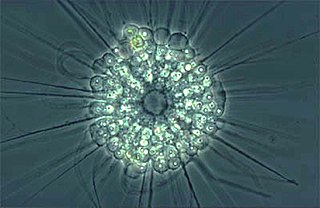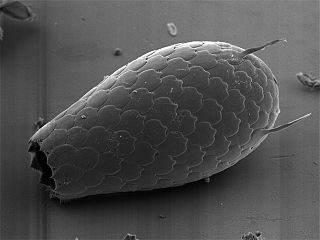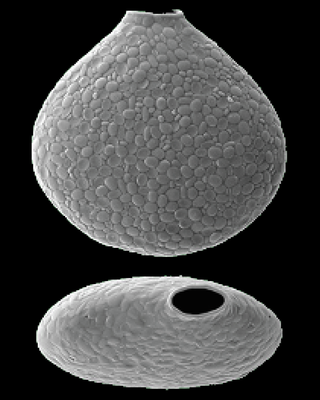
The actinophryids are an order of heliozoa, a polyphyletic array of stramenopiles, having a close relationship with pedinellids and Ciliophrys. They are common in fresh water and occasionally found in marine and soil habitats. Actinophryids are unicellular and roughly spherical in shape, with many axopodia that radiate outward from the cell body. Axopodia are a type of pseudopodia that are supported by hundreds of microtubules arranged in interlocking spirals and forming a needle-like internal structure or axoneme. Small granules, extrusomes, that lie under the membrane of the body and axopodia capture flagellates, ciliates and small metazoa that make contact with the arms.
The gymnosphaerids are a small group of heliozoan protists found in marine environments. They tend to be roughly spherical with radially directed axopods, supported by microtubules in a triangular-hexagonal array arising from an amorphous central granule.

Nucleariida is a group of amoebae with filose pseudopods, known mostly from soils and freshwater. They are distinguished from the superficially similar vampyrellids mainly by having mitochondria with discoid cristae, in the absence of superficial granules, and in the way they consume food.

The centrohelids or centroheliozoa are a large group of heliozoan protists. They include both mobile and sessile forms, found in freshwater and marine environments, especially at some depth.

Pedinellales is a group of single-celled algae found in both marine environments and freshwater.

The euglyphids are a prominent group of filose amoebae that produce shells or tests that in most described species is reinforced by siliceous scales, plates, and sometimes spines, but this reinforcement is absent in other species. These elements are created within the cell and then assembled on its surface in a more or less regular arrangement, giving the test a textured appearance. There is a single opening for the long slender pseudopods, which capture food and pull the cell across the substrate.

The tectofilosids are a group of filose amoebae with shells. These are composed of organic materials and sometimes collected debris, in contrast to the euglyphids, which produce shells from siliceous scales. The shell usually has a single opening, but in Amphitrema and a few other genera it has two on opposite ends. The cell itself occupies most of the shell. They are most often found on marsh plants such as Sphagnum.

Discosea is a class of Amoebozoa, consisting of naked amoebae with a flattened, discoid body shape. Members of the group do not produce tubular or subcylindrical pseudopodia, like amoebae of the class Tubulinea. When a discosean is in motion, a transparent layer called hyaloplasm forms at the leading edge of the cell. In some discoseans, short "subpseudopodia" may be extended from this hyaloplasm, but the granular contents of the cell do not flow into these, as in true pseudopodia. Discosean amoebae lack hard shells, but some, like Cochliopodium and Korotnevella secrete intricate organic scales which may cover the upper (dorsal) surface of the cell. No species have flagella or flagellated stages of life.

Nuclearia is a nucleariid genus.

Testate amoebae are a polyphyletic group of unicellular amoeboid protists, which differ from naked amoebae in the presence of a test that partially encloses the cell, with an aperture from which the pseudopodia emerge, that provides the amoeba with shelter from predators and environmental conditions.

The cryptomonads-haptophytes assemblage is a proposed but disputed monophyletic grouping of unicellular eukaryotes that are not included in the SAR supergroup. Several alternative names have been used for the group, including Hacrobia ; CCTH ; and "Eukaryomonadae".
Roombia truncata is a species of katablepharids, which are heterotrophic single-celled organisms.
The katablepharids, a group of heterotrophic flagellates, have been considered as part of the Cryptista since katablepharids were described in 1939. Although they differ from other cryptophytes and have even been proposed to be alveolates, early 21st century research suggests they are related to cryptophytes.

Katabia is a genus of soil-dwelling heterotrophic flagellate cercozoans containing the single species Katabia gromovi, and the only member of family Katabiidae.

Raphidiophrys contractilis is a species of freshwater centrohelid.

Raphidiophryidae is a family of mostly freshwater centrohelids. It is the sister family of Acanthocystidae, sharing the trait of presenting silica scales and comprising the clade Chalarothoracina. Two genera, Raphidiophrys and Polyplacocystis, have been discovered so far.
Raphidiophrys drakena is a species of protist in the genus of Raphidiophrys. It is a unicellular eukaryote with a cell diameter of 26.7±0.39 μm and several cell surface features like axopodia, kinecysts and a tangential scale layer. The scales have a length of 6.0±0.18 μm and a width of 3.5±0.14 μm. R. drakena differs from other morphologically studied members of the genus Rhaphidiophrys by lacking spicules on its surface.

Nebela is a diverse genus of testate amoebae of cosmopolitan distribution, belonging to the family Hyalospheniidae. They are "prey agglutinated" or "kleptosquamic" organisms, meaning they take the inorganic plates from their prey to construct their test.

Ultrastructural identity is a concept in biology. It asserts that evolutionary lineages of eukaryotes in general and protists in particular can be distinguished by complements and arrangements of cellular organelles. These ultrastructural components can be visualized by electron microscopy.

Alabasta is a genus of arcellinid testate amoebae belonging to the family Hyalospheniidae. It contains species with an elongated test and a strongly curved "pseudostome" with a flare and a notch in narrow view. These species previously belonged to the genus Nebela, but were later found to be a distinct monophyletic group different from Nebela. It is the sister group to Planocarina.













